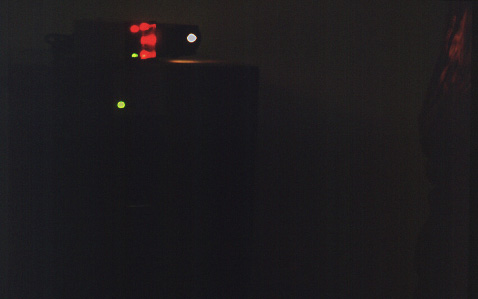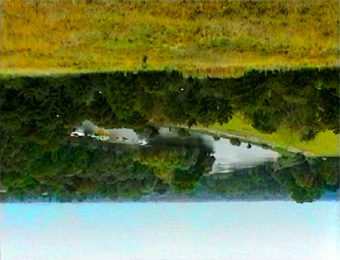1997 – 98
Laing Art Gallery, Newcastle upon Tyne and Lux Gallery (formerly London Electronic Arts Gallery)
Solo exhibition co-commissioned by Tyne and Wear Museums and Film and Video Umbrella with funding from Arts Council England
This exhibition consists of a series of small installations involving video projections, sound and kinetic elements.
Dysfunctional behaviour, often of a droll and disarming nature, is a recurring motif of many of the pieces. In the various video sequences, the little robots’ fitful, faltering attempts to find their way in the world have a very real pathos that belies the edgy, slightly menacing quality of the ‘suspect devices’ in which they are concealed. Contrasting the myth of ‘smart’ technology with its frequently dumb reality, Collins has clearly hit upon a subject with an endless and genuinely affecting comic potential. If the robots’ behaviour is flawed, they seem very human flaws, ones we respond to instinctively, benignly. (Especially should we begin to detect some sort of equivalence between their awkward, stop-go movements and our own somewhat disconcerted fumblings round Collins’ quietly disorientating installation environment.)
While not as immediately attention-grabbing as her public-sited work, ‘Suspect Devices’ insinuates itself gently into the imagination, generating a series of little after-shocks long after one has exited the gallery space.
– Steven Bode, Suspect Devices catalogue
Art: Fatally flawed gadgetry
SCIENTISTS ARGUE that within 10 years we’ll see computers of superhuman intelligence. Pessimists say we will be lucky if they keep us as pets. Susan Collins, head of electronic media at the Slade, sees things differently. In Suspect Devices, a minimalist exhibition of projected images, the robot she presents is a clockwork cockroach under a dislodged floor-tile. The cockroach twitches on its back, emitting a stuttering hum. It is pathetically primitive.
By critiquing the myth of smart technology, Collins calls into question the practicality of our everyday machines, invoking CDs that judderingly stick; computers that bomb; paranoid car alarms.
Humour infuses the best of Collins’ work. She once broadcast sighs, coughs and groans at Nottingham station to infuriate delayed passengers (she succeeded). Other earlier installations include nymphomaniac fruit canoodling while precariously perched on the toned body of a banana.
In Suspect Devices too, sex of an extremely dubious nature is a motif. A predatory camera tracks you, projecting a ghostly hand which fondles your stomach, creeps up to your chest and squeezes before swooping gracefully for the crotch. What makes the image especially disturbing is the fact you can’t see the hand as it gropes your body. Only an observer can – a voyeur’s dream.
Likewise the animated creatures writhing rhythmically in a suitcase look designed to please a cold, lascivious eye. As the jaws of the case uncannily open, you blink and can’t distinguish what is what. Then the two participants jump apart, revealing themselves as a pair of toy dogs. They grunt and sniff each other.
What do you make of the Richmond landscape projected upside-down by a camera obscura? Initially nothing. But if you linger you glimpse a sprinting yeti that vanishes abruptly, and the scene returns to its dreamy calm shared by another item: a field of sheep trapped in a filing cabinet. It’s a comment on the notion of the paperless society. When that day dawns, asks Collins, what will we do with our office furniture? The cabinet functions absurdly as a conservation site for our natural heritage.
The one gadget that appears to have a practical purpose is the security camera. But no, according to the catalogue, it’s merely to emphasise an interior that is not domestic but official and desolate – a lost property bureau perhaps.
Such prompts are valuable. Unless you look closely at Suspect Devices you miss the magic of this buzzing menagerie.
– David Wilson, Independent, The (London), Sep 7, 1998



